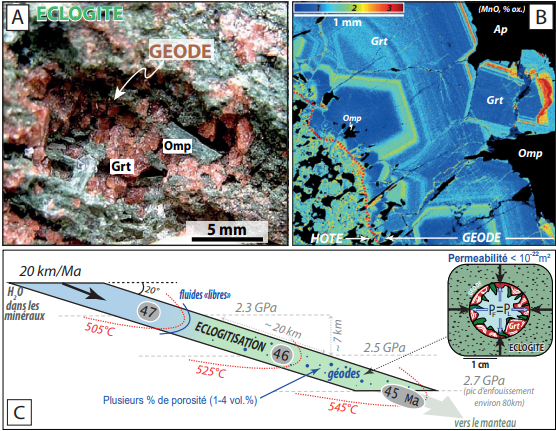Publication of the LGL-TPE in the journal Geology on May 12, 2022. CNRS-INSU communication on May 23, 2022.
We report the finding of rare eclogite-facies vugs forming millimeter- to centimeter-sized pockets in meta-ophiolites from the western European Alps. Euhedral garnet crystals covering the vug walls display oscillatory chemical zoning for a wide range of major and trace elements, including Cr, Mn, and rare earth elements. Thermodynamic modeling revealed that closed-system fluid production through the breakdown of prograde glaucophane, lawsonite, and chlorite between 505 °C and 525 °C can successfully explain porosity creation of ~4% and the mineralogical properties of the vugs. Available geologic and geochronologic constraints indicate that the eclogitization of the downgoing mafic crust spanned a window of at least 1 m.y. These observations can only be explained by the presence of extremely low permeability values (<10–22 m2) to keep the fluid confined at the meter scale within vugs on such time scales. Our field-based report of eclogite porosity provides the first in situ confirmation of previous experimental data and geophysical estimates on active margins. A substantial amount of fluid trapped in this porosity may be carried deeper than expected into Earth’s mantle, with implications for volatile recycling budgets.

(B) Chemical map of manganese concentration by electron probe showing the difference in texture between the host (bottom left, fine grains) and the edge of the geode where large garnet grains (Grt) lining the walls show chemical oscillations, typical of mineral growth in the presence of a fluid phase.
(C) Conceptual diagram locating the processes by which eclogitic geodes form in the subducting oceanic plate, between 70 and 80 km depth, when fluids (under pressures equal to those undergone by the rock) remain trapped in the pores of the eclogite, leading to the genesis of a porosity of the order of several percent (by volume).
Illustration and figure credits: S. Anbigoust
Reference: Permeability of subducted oceanic crust revealed by eclogite-facies vugs. Samuel Angiboust, Tom Raimondo. Geology, May 12,2022.
DOI : https://doi.org/10.1130/G50066.1






